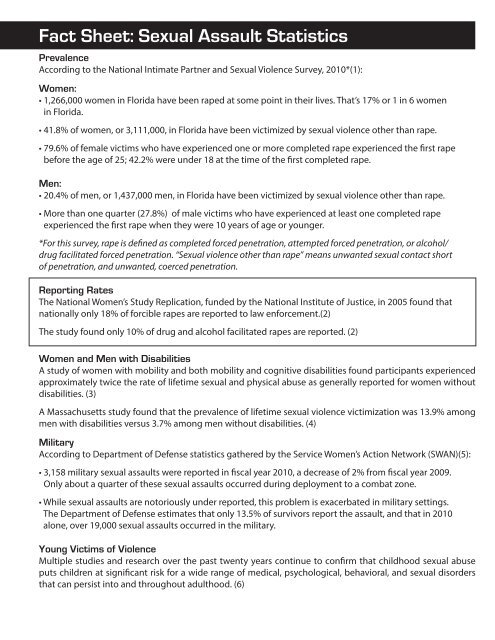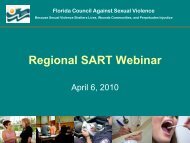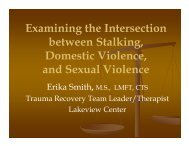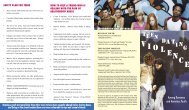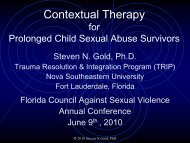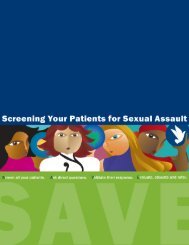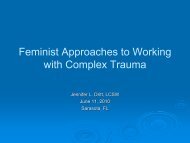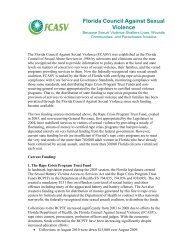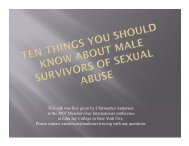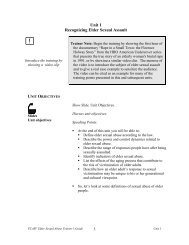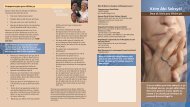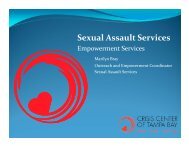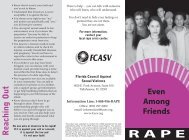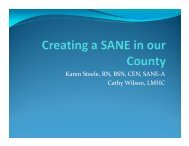Fact Sheet:: Sexual Assault Statistics - Florida Council Against ...
Fact Sheet:: Sexual Assault Statistics - Florida Council Against ...
Fact Sheet:: Sexual Assault Statistics - Florida Council Against ...
Create successful ePaper yourself
Turn your PDF publications into a flip-book with our unique Google optimized e-Paper software.
<strong>Fact</strong> <strong>Sheet</strong>:: <strong>Sexual</strong> <strong>Assault</strong> <strong>Statistics</strong><br />
Prevalence<br />
According to the National Intimate Partner and <strong>Sexual</strong> Violence Survey, 2010*(1):<br />
Women:<br />
• 1,266,000 women in <strong>Florida</strong> have been raped at some point in their lives. That’s 17% or 1 in 6 women<br />
in <strong>Florida</strong>.<br />
• 41.8% of women, or 3,111,000, in <strong>Florida</strong> have been victimized by sexual violence other than rape.<br />
• 79.6% of female victims who have experienced one or more completed rape experienced the first rape<br />
before the age of 25; 42.2% were under 18 at the time of the first completed rape.<br />
Men:<br />
• 20.4% of men, or 1,437,000 men, in <strong>Florida</strong> have been victimized by sexual violence other than rape.<br />
• More than one quarter (27.8%) of male victims who have experienced at least one completed rape<br />
experienced the first rape when they were 10 years of age or younger.<br />
*For this survey, rape is defined as completed forced penetration, attempted forced penetration, or alcohol/<br />
drug facilitated forced penetration. “<strong>Sexual</strong> violence other than rape” means unwanted sexual contact short<br />
of penetration, and unwanted, coerced penetration.<br />
Reporting Rates<br />
The National Women’s Study Replication, funded by the National Institute of Justice, in 2005 found that<br />
nationally only 18% of forcible rapes are reported to law enforcement.(2)<br />
The study found only 10% of drug and alcohol facilitated rapes are reported. (2)<br />
Women and Men with Disabilities<br />
A study of women with mobility and both mobility and cognitive disabilities found participants experienced<br />
approximately twice the rate of lifetime sexual and physical abuse as generally reported for women without<br />
disabilities. (3)<br />
A Massachusetts study found that the prevalence of lifetime sexual violence victimization was 13.9% among<br />
men with disabilities versus 3.7% among men without disabilities. (4)<br />
Military<br />
According to Department of Defense statistics gathered by the Service Women’s Action Network (SWAN)(5):<br />
• 3,158 military sexual assaults were reported in fiscal year 2010, a decrease of 2% from fiscal year 2009.<br />
Only about a quarter of these sexual assaults occurred during deployment to a combat zone.<br />
• While sexual assaults are notoriously under reported, this problem is exacerbated in military settings.<br />
The Department of Defense estimates that only 13.5% of survivors report the assault, and that in 2010<br />
alone, over 19,000 sexual assaults occurred in the military.<br />
Young Victims of Violence<br />
Multiple studies and research over the past twenty years continue to confirm that childhood sexual abuse<br />
puts children at significant risk for a wide range of medical, psychological, behavioral, and sexual disorders<br />
that can persist into and throughout adulthood. (6)
The 2009 National Survey of Children’s Exposure to Violence, found:<br />
• 6.1% of all children surveyed had been sexually victimized in the past year and nearly 1 in 10 (9.8%)<br />
over their lifetimes.<br />
• Adolescents ages 14-17 were by far the most likely to be sexually victimized; nearly one in six (16.3%)<br />
was sexually victimized in the past year.<br />
• More than one in four adolescents (27.3%) had been sexually victimized during their lifetimes most<br />
commonly by flashing/exposure by a peer, sexual harassment and sexual assault.<br />
References<br />
1. Black, M.C., Basile, K.C., Breiding, M.J., Smith, S.G., Walters, M.L., Merrick, M.T., Chen, J., & Stevens, M.R.<br />
(2011). The National Intimate Partner and <strong>Sexual</strong> Violence Survey (NISVS): 2010 Summary Report. Atlanta,<br />
GA: National Center for Injury Prevention and Control, Centers for Disease Control and Prevention.<br />
2. Kilpatrick, Dean G., Ph.D. (2010, September 14) Hearing before the Senate Committee on the Judiciary<br />
Subcommittee on Crime and Drugs “Rape in the United States: The Chronic Failure to Report and<br />
Investigate Rape Cases.”<br />
3. Powers, E.L., Curry, M.A., Oschwald, M., Maley, S., Saxton, M., & Eckels, K. (2002). Barriers and strategies<br />
in addressing abuse: A survey of disabled women’s experiences. Journal of Rehabilitation, 68(1), 4-13.<br />
4. Mitra, Monika, PhD, Mouradian, Vera E., PhD, Diamond, Marci, MPA. (2011) <strong>Sexual</strong> Violence Victimization<br />
<strong>Against</strong> Men with Disabilities. American Journal of Preventive Medicine.<br />
5. Stalsburg, B. (July 2011). Rape, <strong>Sexual</strong> <strong>Assault</strong> and <strong>Sexual</strong> Harassment in the Military: The Quick <strong>Fact</strong>s.<br />
Service Women’s Action Network. Retrieved May 18, 2012, from http://servicewomen.org/wp-content/<br />
uploads/2012/03/Rape-<strong>Sexual</strong>-<strong>Assault</strong>-and-<strong>Sexual</strong>-Harassment-in-the-Military.pdf.<br />
6. Maniglio, R. (2009). The Impact of Child <strong>Sexual</strong> Abuse on Health: A systematic review of reviews.<br />
Clinical Psychology Review.<br />
7. Finkelhor, D., Turner, H., Ormrod, R. K., Hamby, S. L., & Krack, K. (2009). Children’s exposure to violence:<br />
A comprehensive national survey. Juvenile Justice Bulletin, 1–11.<br />
1820 E. Park Avenue, Suite 100 • Tallahassee, FL 32301<br />
tel: (850) 297-2000 • fax: (850) 297-2002<br />
www.fcasv.org


